 | ÐлекÑÑоннÑй компоненÑ: FGH50N3 | СкаÑаÑÑ:  PDF PDF  ZIP ZIP |
Äîêóìåíòàöèÿ è îïèñàíèÿ www.docs.chipfind.ru
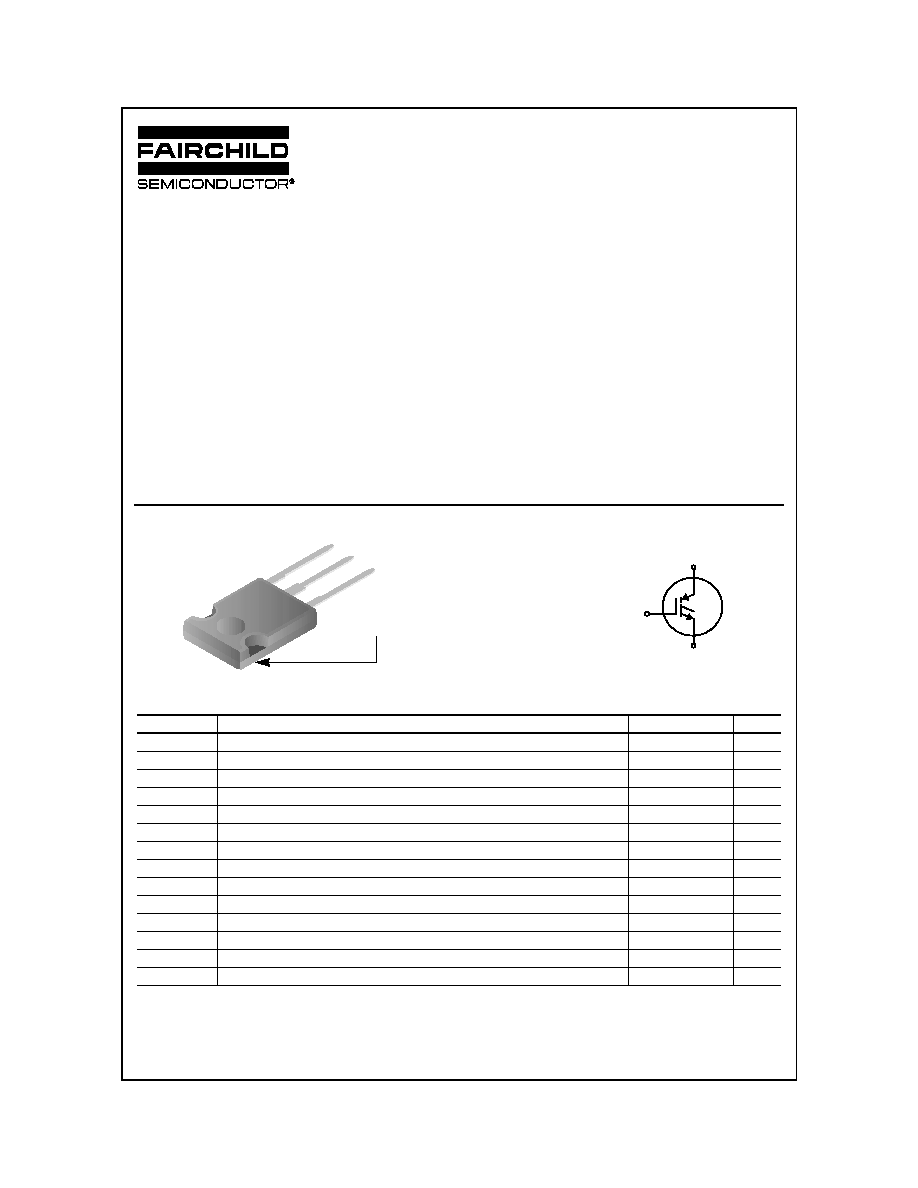
©2002 Fairchild Semiconductor Corporation
July 2002
FGH50N3 Rev. A
FGH50N3
FGH50N3
300V, PT N-Channel IGBT
General Description
The FGH50N3 is a MOS gated high voltage switching
device combining the best features of MOSFETs and
bipolar transistors. These devices have the high input
impedance of a MOSFET and the low on-state conduction
loss of a bipolar transistor. The much lower on-state voltage
drop varies only moderately between 25
o
C and 150
o
C.
This IGBT is ideal for many high voltage switching
applications operating at high frequencies where low
conduction losses are essential. This device has been
optimized for medium frequency switch mode power
supplies.
Formerly Developmental Type TA49485
Features
· Low V
CE(SAT)
. . . . . . . . . . . . . . . . . . . < 1.4V max
· Low E
OFF
. . . . . . . . . . . . . . . . . . . . . . . . . < 200
µ
J
· SCWT (@ T
J
= 125°C). . . . . . . . . . . . . . . . . > 8
µ
s
· 300V Switching SOA Capability
· Positive V
CE(SAT)
Temperature Coefficient above
50A
Device Maximum Ratings
T
C
= 25°C unless otherwise noted
Symbol
Parameter
Ratings
Units
BV
CES
Collector to Emitter Breakdown Voltage
300
V
I
C25
Collector Current Continuous, T
C
= 25°C
75
A
I
C110
Collector Current Continuous, T
C
= 110°C
75
A
I
CM
Collector Current Pulsed (Note 1)
240
A
V
GES
Gate to Emitter Voltage Continuous
±20
V
V
GEM
Gate to Emitter Voltage Pulsed
±30
V
SSOA
Switching Safe Operating Area at T
J
= 150°C, Figure 2
150A at 300V
E
AS
Single Pulse Avalanche Energy, I
CE
= 30A, L = 1.78mH, V
DD
= 50V
800
mJ
E
ARV
Single Pulse Reverse Avalanche Energy, I
EC
= 30A, L = 1.78mH, V
DD
= 50V
800
mJ
P
D
Power Dissipation Total T
C
= 25°C
463
W
Power Dissipation Derating T
C
> 25°C
3.7
W/°C
T
J
Operating Junction Temperature Range
-55 to 150
°C
T
STG
Storage Junction Temperature Range
-55 to 150
°C
t
SC
Short Circuit Withstand Time (Note 2)
8
µ
s
CAUTION: Stresses above those listed in "Device Maximum Ratings" may cause permanent damage to the device. This is a stress only rating and
operation of the device at these or any other conditions above those indicated in the operational sections of this specification is not implied.
NOTE:
1. Pulse width limited by maximum junction temperature.
2. V
CE(PK)
= 180V, T
J
= 125°C, V
GE
= 12Vdc, R
G
= 5
Package
Symbol
TO-247
E
C
G
COLLECTOR
C
E
G
(FLANGE)

©2002 Fairchild Semiconductor Corporation
FGH50N3 Rev. A
FGH50N3
Package Marking and Ordering Information
Electrical Characteristics
T
J
= 25°C unless otherwise noted
Off State Characteristics
On State Characteristics
Dynamic Characteristics
Switching Characteristics
Thermal Characteristics
Device Marking
Device
Package
Tape Width
Quantity
FGH50N3
FGH50N3
TO-247
N/A
30
Symbol
Parameter
Test Conditions
Min
Typ
Max
Units
BV
CES
Collector to Emitter Breakdown Voltage I
CE
= 250
µ
A, V
GE
= 0V
300V
-
-
V
BV
ECS
Emitter to Collector Breakdown Voltage I
EC
= 10mA, V
GE
= 0V
15V
-
-
V
I
CES
Collector to Emitter Leakage Current
V
CE
= 300V
T
J
= 25°C
-
-
250
µ
A
T
J
= 125°C
-
-
2.0
mA
I
GES
Gate to Emitter Leakage Current
V
GE
= ± 20V
-
-
±250
nA
V
CE(SAT)
Collector to Emitter Saturation Voltage I
CE
= 30A
V
GE
= 15V
T
J
= 25°C
-
1.30
1.4
V
T
J
= 125°C
-
1.25
1.4
V
Q
G(ON)
Gate Charge
I
CE
= 30A
V
CE
= 150V
V
GE
= 15V
-
180
-
nC
V
GE
= 20V
-
228
-
nC
V
GE(TH)
Gate to Emitter Threshold Voltage
I
CE
= 250
µ
A, V
CE
= V
GE
4.0
4.8
5.5
V
V
GEP
Gate to Emitter Plateau Voltage
I
CE
= 30A, V
CE
= 150V
-
7.0
-
V
SSOA
Switching SOA
T
J
= 150°C, R
G
= 5
,
V
GE
= 15V , L = 25
µ
H,
Vce = 300V
150
-
-
A
t
d(ON)I
Current Turn-On Delay Time
IGBT and Diode at T
J
= 25°C,
I
CE
= 30A,
V
CE
= 180V,
V
GE
= 15V,
R
G
= 5
,
L = 100
µ
H,
Test Circuit - Figure 20
-
20
-
ns
t
rI
Current Rise Time
-
15
-
ns
t
d(OFF)I
Current Turn-Off Delay Time
-
135
-
ns
t
fI
Current Fall Time
-
12
-
ns
E
ON2
Turn-On Energy (Note 1)
-
130
-
µ
J
E
OFF
Turn-Off Energy (Note 2)
-
92
120
µ
J
t
d(ON)I
Current Turn-On Delay Time
IGBT and Diode at T
J
= 125°C,
I
CE
= 30A,
V
CE
= 180V,
V
GE
= 15V,
R
G
= 5
,
L = 100
µ
H,
Test Circuit - Figure 20
-
19
-
ns
t
rI
Current Rise Time
-
13
-
ns
t
d(OFF)I
Current Turn-Off Delay Time
-
155
190
ns
t
fI
Current Fall Time
-
7
15
ns
E
ON2
Turn-On Energy (Note 1)
-
225
270
µ
J
E
OFF
Turn-Off Energy (Note 2)
-
135
200
µ
J
R
JC
Thermal Resistance Junction-Case
TO-247
-
-
0.27
°C/W
NOTE:
1.
E
ON2
is the turn-on loss when a typical diode is used in the test circuit and the diode is at the same T
J
as the IGBT.
The diode type is specified in figure 20.
2.
Turn-Off Energy Loss (E
OFF
) is defined as the integral of the instantaneous power loss starting at the trailing edge of
the input pulse and ending at the point where the collector current equals zero (I
CE
= 0A). All devices were tested per
JEDEC Standard No. 24-1 Method for Measurement of Power Device Turn-Off Switching Loss. This test method produc-
es the true total Turn-Off Energy Loss.
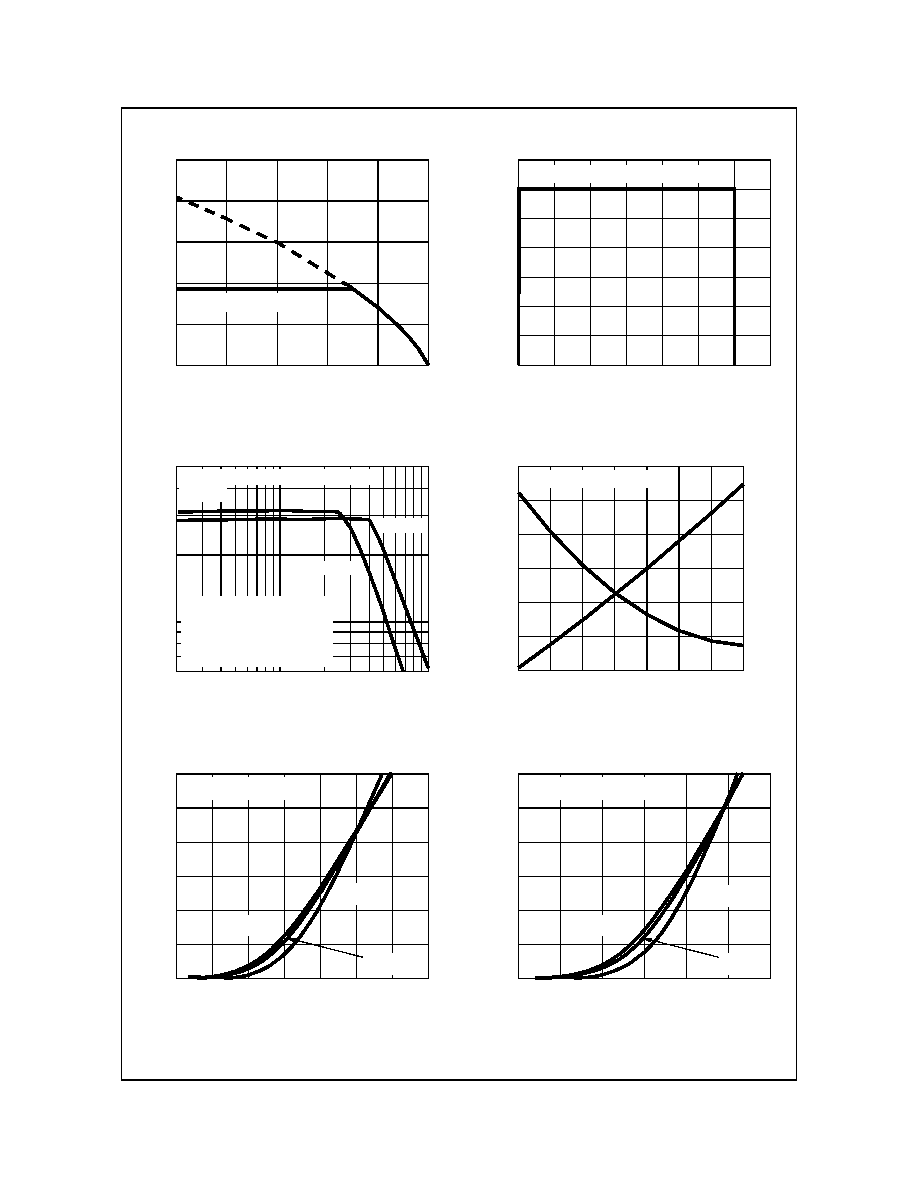
©2002 Fairchild Semiconductor Corporation
FGH50N3 Rev. A
FGH50N3
Typical Performance Curves
T
J
= 25°C unless otherwise noted
Figure 1. DC Collector Current vs Case
Temperature
Figure 2. Minimum Switching Safe Operating Area
Figure 3. Operating Frequency vs Collector to
Emitter Current
Figure 4. Short Circuit Withstand Time
Figure 5. Collector to Emitter On-State Voltage
Figure 6. Collector to Emitter On-State Voltage
T
C
, CASE TEMPERATURE (
o
C)
I
CE
, DC COL
L
ECT
O
R CURRENT
(
A
)
50
40
0
80
25
75
100
125
150
200
160
120
V
GE
= 15V
PACKAGE LIMITED
40
V
CE
, COLLECTOR TO EMITTER VOLTAGE (V)
350
0
I
CE
, CO
L
L
E
CT
O
R
T
O
EM
IT
T
E
R CURRE
NT
(
A
)
150
200
100
50
250
300
0
75
125
50
175
T
J
= 150
o
C, R
G
= 5
, V
GE
= 15V, L = 25
µ
H
150
100
25
f
MA
X
, OP
E
R
A
T
ING F
R
E
Q
UE
NCY
(kHz)
I
CE
, COLLECTOR TO EMITTER CURRENT (A)
T
J
= 125
o
C, R
G
= 5
, L = 100
µ
H, V
CE
= 180V
f
MAX1
= 0.05 / (t
d(OFF)I
+ t
d(ON)I
)
R
ØJC
= 0.27
o
C/W, SEE NOTES
P
C
= CONDUCTION DISSIPATION
(DUTY FACTOR = 50%)
f
MAX2
= (P
D
- P
C
) / (E
ON2
+ E
OFF
)
V
GE
= 15V
T
C =
75
o
C
V
GE
= 10V
60
100
200
300
400
500
2
10
20
100
V
GE
, GATE TO EMITTER VOLTAGE (V)
I
SC
, PEA
K SHOR
T
CIRCU
I
T
CURRE
NT
(
A
)
t
SC
, SHOR
T
C
I
R
CUIT
WIT
H
ST
AND T
I
M
E
(
µ
s)
9
11
12
20
10
300
500
13
14
25
15
200
400
600
800
10
16
5
0
t
SC
I
SC
V
CE
= 180V, R
G
= 5
, T
J
= 125
o
C
15
700
30
0.25
0.75
V
CE
, COLLECTOR TO EMITTER VOLTAGE (V)
I
CE
, COL
L
ECT
O
R T
O
EM
IT
T
E
R CURRE
NT
(
A
)
0
10
20
1.0
1.75
40
30
60
0.5
T
J
= 150
o
C
1.25
1.5
PULSE DURATION = 250
µ
s
DUTY CYCLE < 0.5%, V
GE
= 10V
T
J
= 125
o
C
50
2.0
T
J
= 25
o
C
I
CE
, COL
L
ECT
O
R T
O
EM
IT
T
E
R CURRE
NT
(
A
)
V
CE
, COLLECTOR TO EMITTER VOLTAGE (V)
T
J
= 125
o
C
PULSE DURATION = 250
µ
s
DUTY CYCLE < 0.5%, V
GE
= 15V
0
10
20
40
30
60
50
0.25
0.5
0.75
1.0
1.25
1.5
1.75
T
J
= 150
o
C
T
J
= 25
o
C
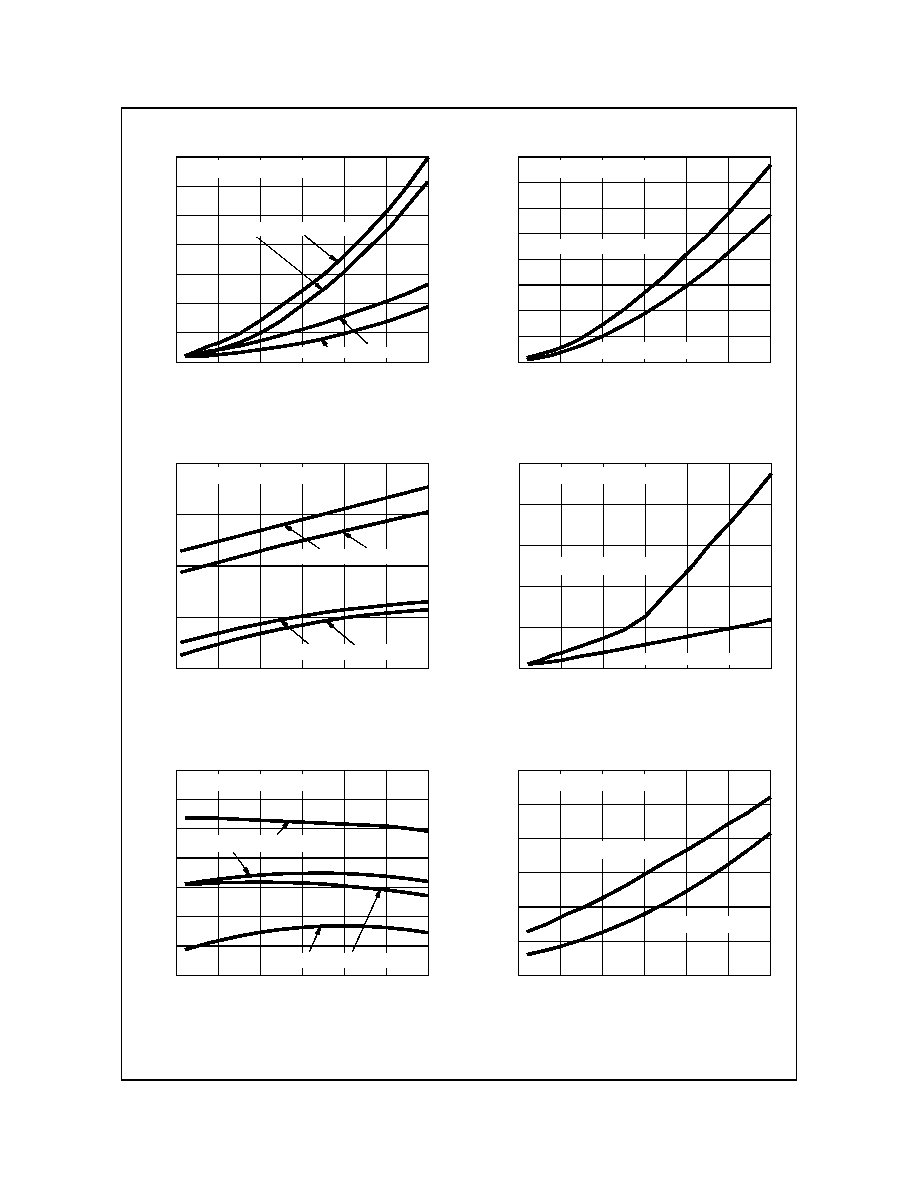
©2002 Fairchild Semiconductor Corporation
FGH50N3 Rev. A
FGH50N3
Figure 7. Turn-On Energy Loss vs Collector to
Emitter Current
Figure 8. Turn-Off Energy Loss vs Collector to
Emitter Current
Figure 9. Turn-On Delay Time vs Collector to
Emitter Current
Figure 10. Turn-On Rise Time vs Collector to
Emitter Current
Figure 11. Turn-Off Delay Time vs Collector to
Emitter Current
Figure 12. Fall Time vs Collector to Emitter
Current
Typical Performance Curves
T
J
= 25°C unless otherwise noted (Continued)
E
ON
2
,
T
URN-
ON ENER
G
Y
L
O
SS
(
m
J
)
I
CE
, COLLECTOR TO EMITTER CURRENT (A)
T
J
= 25
o
C, T
J
= 125
o
C, V
GE
= 10V
T
J
= 25
o
C, T
J
= 125
o
C, V
GE
= 15V
R
G
= 5
, L = 100
µ
H, V
CE
= 180V
0
0.2
0.4
0.6
0.8
1.0
1.2
1.4
0
10
20
30
40
50
60
0
50
100
150
200
250
300
350
400
E
OF
F
T
URN-
O
F
F
E
N
ERGY L
O
SS (
µ
J)
I
CE
, COLLECTOR TO EMITTER CURRENT (A)
T
J
= 125
o
C, V
GE
= 10V, V
GE
= 15V
T
J
= 25
o
C, V
GE
= 10V, V
GE
= 15V
R
G
= 5
, L = 100
µ
H, V
CE
= 180V
0
10
20
30
40
50
60
I
CE
, COLLECTOR TO EMITTER CURRENT (A)
t
d(O
N
)I
,
T
URN-
ON DEL
A
Y
T
I
M
E
(
n
s
)
15
20
25
T
J
= 25
o
C, T
J
= 125
o
C, V
GE
= 15V
T
J
= 25
o
C, T
J
= 125
o
C, V
GE
= 10V
30
35
0
10
20
30
40
50
60
R
G
= 5
, L = 100
µ
H, V
CE
= 180V
I
CE
, COLLECTOR TO EMITTER CURRENT (A)
t
rI
,
R
IS
E
T
I
ME
(n
s)
T
J
= 25
o
C, T
J
= 125
o
C, V
GE
= 10V
T
J
= 25
o
C, T
J
= 125
o
C, V
GE
=15V
0
10
20
30
40
50
60
0
20
40
60
80
100
R
G
= 5
, L = 100
µ
H, V
CE
= 180V
I
CE
, COLLECTOR TO EMITTER CURRENT (A)
t
d(
O
F
F)
I
, T
URN-
OF
F
DE
L
A
Y T
I
M
E
(
n
s
)
0
10
20
30
40
50
60
T
J
= 25
o
C, T
J
= 125
o
C, V
GE
= 15V
T
J
= 25
o
C, T
J
= 125
o
C, V
GE
= 10V
100
110
120
130
140
150
160
170
R
G
= 5
, L = 100
µ
H, V
CE
= 180V
I
CE
, COLLECTOR TO EMITTER CURRENT (A)
t
fI
,
F
A
LL
TI
M
E
(
n
s
)
T
J
= 25
o
C, V
GE
= 10V, 15V
T
J
= 125
o
C, V
GE
= 10V, 15V
R
G
= 5
, L = 100
µ
H, V
CE
= 180V
0
10
20
30
40
50
60
0
4
8
16
12
24
20
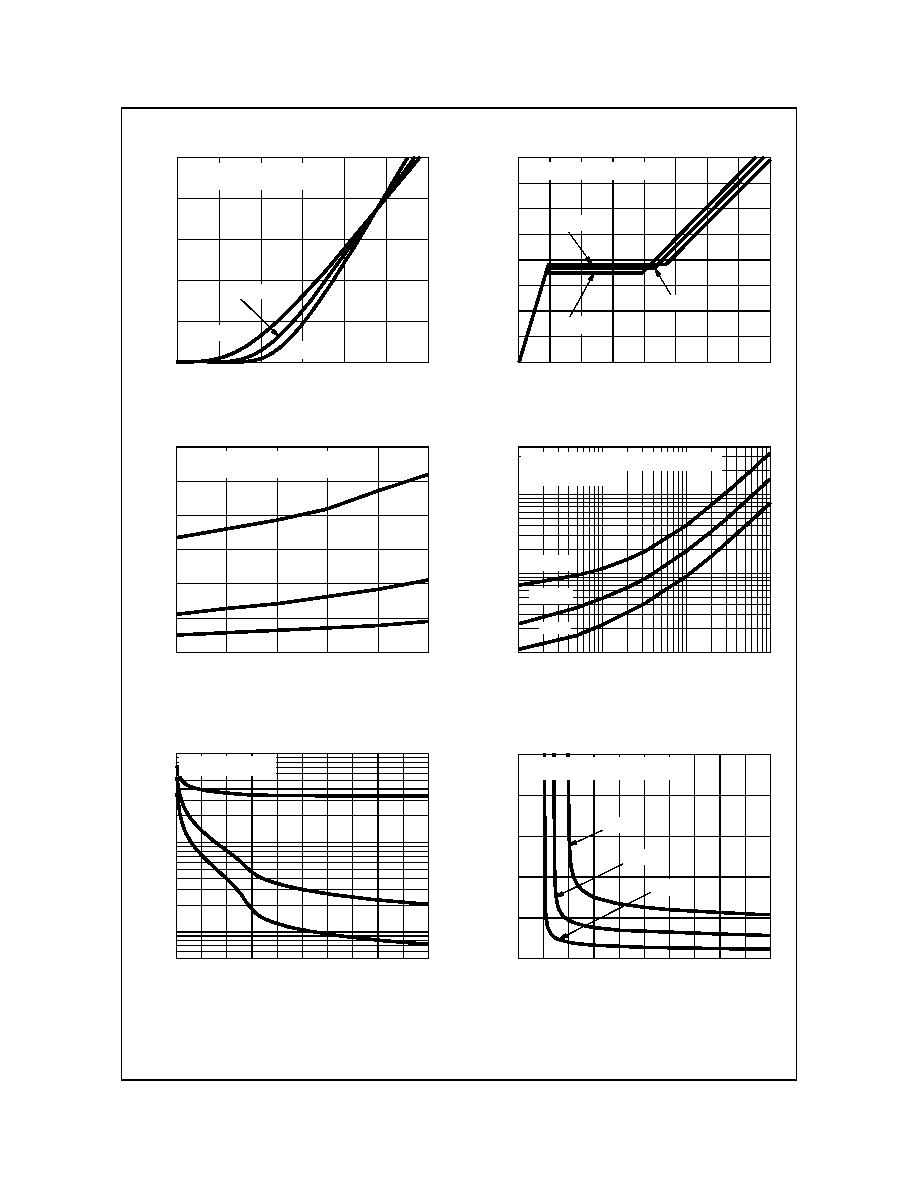
©2002 Fairchild Semiconductor Corporation
FGH50N3 Rev. A
FGH50N3
Figure 13. Transfer Characteristic
Figure 14. Gate Charge
Figure 15. Total Switching Loss vs Case
Temperature
Figure 16. Total Switching Loss vs Gate
Resistance
Figure 17. Capacitance vs Collector to Emitter
Voltage
Figure 18. Collector to Emitter On-State Voltage vs
Gate to Emitter Voltage
Typical Performance Curves
T
J
= 25°C unless otherwise noted (Continued)
I
CE
, COL
L
E
C
T
O
R T
O
E
M
IT
T
E
R CURRENT
(
A
)
V
GE
, GATE TO EMITTER VOLTAGE (V)
T
J
= 125
o
C
T
J
= -55
o
C
PULSE DURATION = 250
µ
s
DUTY CYCLE < 0.5%, V
CE
= 10V
T
J
= 25
o
C
5
6
7
8
9
10
11
0
50
100
150
200
250
V
GE
, GA
T
E
T
O
E
M
I
T
T
E
R V
O
L
T
A
GE
(V
)
Q
G
, GATE CHARGE (nC)
I
G(REF)
= 1mA, R
L
= 5
, T
J
= 25
o
C
V
CE
= 100V
V
CE
= 300V
V
CE
= 200V
25
50
75
100
125
200
0
150
175
0
2
4
6
8
10
12
14
16
T
C
, CASE TEMPERATURE (
o
C)
E
TO
T
A
L
,
T
O
T
A
L S
W
I
T
CHI
NG
EN
ERG
Y
L
O
SS (
m
J)
R
G
= 5
, L = 100
µ
H, V
CE
= 180V, V
GE
= 15V
I
CE
= 60A
E
TOTAL
= E
ON2
+ E
OFF
I
CE
= 30A
I
CE
= 15A
0
0.2
0.4
0.8
0.6
1.2
1.0
50
25
75
100
125
150
R
G
, GATE RESISTANCE (
)
E
TO
T
A
L
, T
O
T
A
L
S
W
IT
CHING E
N
E
R
GY
L
O
S
S
(
m
J)
E
TOTAL
= E
ON2
+ E
OFF
T
J
= 125
o
C, L = 100
µ
H, V
CE
= 180V, V
GE
= 15V
1
0.1
40
10
1
10
100
1000
I
CE
= 60A
I
CE
= 30A
I
CE
= 15A
V
CE
, COLLECTOR TO EMITTER VOLTAGE (V)
C, CAP
A
C
IT
ANC
E (
n
F
)
C
RES
0
10
20
30
40
50
FREQUENCY = 1MHz
C
OES
C
IES
60
70
80
90
100
0.05
10
1.0
0.1
V
GE
, GATE TO EMITTER VOLTAGE (V)
9
8
10
11
12
16
V
CE
, CO
L
L
E
CT
OR T
O
E
M
IT
T
E
R V
O
L
T
A
GE
(V
)
PULSE DURATION = 250
µ
s, T
J
= 25
o
C
7
13
14
15
DUTY CYCLE < 0.5%
I
CE
= 60A
6
I
CE
= 15A
I
CE
= 30A
1.0
1.5
2.0
2.5
3.0
3.5
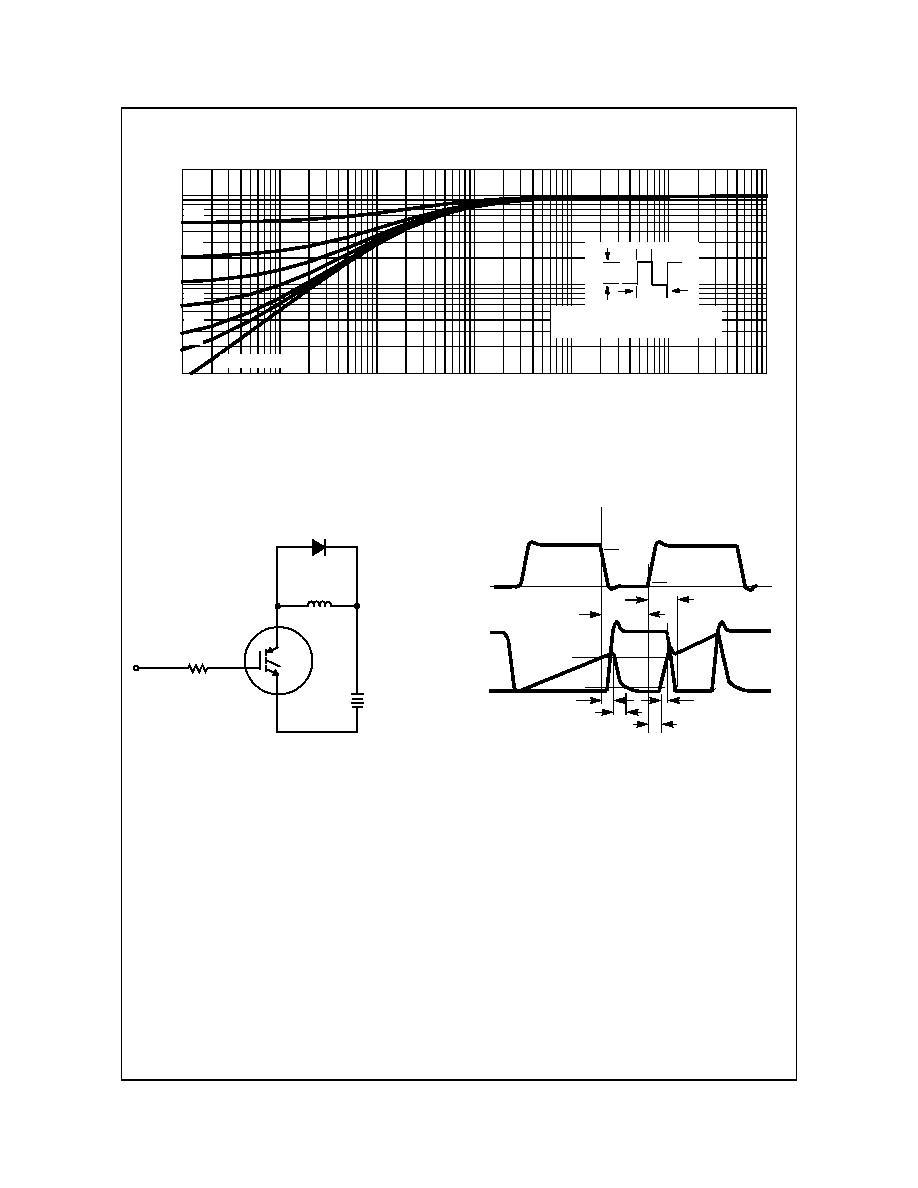
©2002 Fairchild Semiconductor Corporation
FGH50N3 Rev. A
FGH50N3
Figure 19. IGBT Normalized Transient Thermal Impedance, Junction to Case
Typical Performance Curves
T
J
= 25°C unless otherwise noted (Continued)
t
1
, RECTANGULAR PULSE DURATION (s)
Z
JC
,
N
O
R
MAL
I
Z
E
D T
H
ERMAL
RESPO
NSE
10
-2
10
-1
10
0
10
-5
10
-3
10
-2
10
-1
10
0
10
1
10
-4
0.10
t
1
t
2
P
D
DUTY FACTOR, D = t
1
/ t
2
PEAK T
J
= (P
D
X Z
JC
X R
JC
) + T
C
SINGLE PULSE
0.50
0.20
0.05
0.02
0.01
Test Circuit and Waveforms
Figure 20. Inductive Switching Test Circuit
Figure 21. Switching Test Waveforms
R
G
= 5
L = 100
µ
H
V
DD
= 180V
+
-
FFH30US30S
DIODE 49449
FGH50N3
t
fI
t
d(OFF)I
t
rI
t
d(ON)I
10%
90%
10%
90%
V
CE
I
CE
V
GE
E
OFF
E
ON2

©2002 Fairchild Semiconductor Corporation
FGH50N3 Rev. A
FGH50N3
Handling Precautions for IGBTs
Insulated Gate Bipolar Transistors are susceptible to
gate-insulation damage by the electrostatic
discharge of energy through the devices. When
handling these devices, care should be exercised to
assure that the static charge built in the handler's
body capacitance is not discharged through the
device. With proper handling and application
procedures, however, IGBTs are currently being
extensively used in production by numerous
equipment manufacturers in military, industrial and
consumer applications, with virtually no damage
problems due to electrostatic discharge. IGBTs can
be handled safely if the following basic precautions
are taken:
1. Prior to assembly into a circuit, all leads should be
kept shorted together either by the use of metal
shorting springs or by the insertion into conduc-
tive material such as "ECCOSORBDTM LD26" or
equivalent.
2. When devices are removed by hand from their
carriers, the hand being used should be
grounded by any suitable means - for example,
with a metallic wristband.
3. Tips of soldering irons should be grounded.
4. Devices should never be inserted into or removed
from circuits with power on.
5. Gate Voltage Rating - Never exceed the gate-
voltage rating of V
GEM
. Exceeding the rated V
GE
can result in permanent damage to the oxide
layer in the gate region.
6. Gate Termination - The gates of these devices
are essentially capacitors. Circuits that leave the
gate open-circuited or floating should be avoided.
These conditions can result in turn-on of the
device due to voltage buildup on the input
capacitor due to leakage currents or pickup.
7. Gate Protection - These devices do not have an
internal monolithic Zener diode from gate to
emitter. If gate protection is required an external
Zener is recommended.
Operating Frequency Information
Operating frequency information for a typical device
(Figure 3) is presented as a guide for estimating
device performance for a specific application. Other
typical frequency vs collector current (I
CE
) plots are
possible using the information shown for a typical
unit in Figures 5, 6, 7, 8, 9 and 11. The operating
frequency plot (Figure 3) of a typical device shows
f
MAX1
or f
MAX2
; whichever is smaller at each point.
The information is based on measurements of a
typical device and is bounded by the maximum rated
junction temperature.
f
MAX1
is defined by f
MAX1
= 0.05/(t
d(OFF)I
+ t
d(ON)I
).
Deadtime (the denominator) has been arbitrarily held
to 10% of the on-state time for a 50% duty factor.
Other definitions are possible. t
d(OFF)I
and t
d(ON)I
are
defined in Figure 21. Device turn-off delay can
establish an additional frequency limiting condition
for an application other than T
JM
. t
d(OFF)I
is important
when controlling output ripple under a lightly loaded
condition.
f
MAX2
is defined by f
MAX2
= (P
D
- P
C
)/(E
OFF
+ E
ON2
).
The allowable dissipation (P
D
) is defined by
P
D
= (T
JM
- T
C
)/R
JC
. The sum of device switching
and conduction losses must not exceed P
D
. A 50%
duty factor was used (Figure 3) and the conduction
losses (P
C
) are approximated by P
C
= (V
CE
x I
CE
)/2.
E
ON2
and E
OFF
are defined in the switching
waveforms shown in Figure 21. E
ON2
is the integral
of the instantaneous power loss (I
CE
x V
CE
) during
turn-on and E
OFF
is the integral of the instantaneous
power loss (I
CE
x V
CE
) during turn-off. All tail losses
are included in the calculation for E
OFF
; i.e., the
collector current equals zero (I
CE
= 0)
ECCOSORBD
is a Trademark of Emerson and Cumming, Inc.

DISCLAIMER
FAIRCHILD SEMICONDUCTOR RESERVES THE RIGHT TO MAKE CHANGES WITHOUT FURTHER
NOTICE TO ANY PRODUCTS HEREIN TO IMPROVE RELIABILITY, FUNCTION OR DESIGN. FAIRCHILD
DOES NOT ASSUME ANY LIABILITY ARISING OUT OF THE APPLICATION OR USE OF ANY PRODUCT
OR CIRCUIT DESCRIBED HEREIN; NEITHER DOES IT CONVEY ANY LICENSE UNDER ITS PATENT
RIGHTS, NOR THE RIGHTS OF OTHERS.
TRADEMARKS
The following are registered and unregistered trademarks Fairchild Semiconductor owns or is authorized to use and is
not intended to be an exhaustive list of all such trademarks.
LIFE SUPPORT POLICY
FAIRCHILDS PRODUCTS ARE NOT AUTHORIZED FOR USE AS CRITICAL COMPONENTS IN LIFE SUPPORT
DEVICES OR SYSTEMS WITHOUT THE EXPRESS WRITTEN APPROVAL OF FAIRCHILD SEMICONDUCTOR CORPORATION.
As used herein:
1. Life support devices or systems are devices or
systems which, (a) are intended for surgical implant into
the body, or (b) support or sustain life, or (c) whose
failure to perform when properly used in accordance
with instructions for use provided in the labeling, can be
reasonably expected to result in significant injury to the
user.
2. A critical component is any component of a life
support device or system whose failure to perform can
be reasonably expected to cause the failure of the life
support device or system, or to affect its safety or
effectiveness.
PRODUCT STATUS DEFINITIONS
Definition of Terms
Datasheet Identification
Product Status
Definition
Advance Information
Preliminary
No Identification Needed
Obsolete
This datasheet contains the design specifications for
product development. Specifications may change in
any manner without notice.
This datasheet contains preliminary data, and
supplementary data will be published at a later date.
Fairchild Semiconductor reserves the right to make
changes at any time without notice in order to improve
design.
This datasheet contains final specifications. Fairchild
Semiconductor reserves the right to make changes at
any time without notice in order to improve design.
This datasheet contains specifications on a product
that has been discontinued by Fairchild semiconductor.
The datasheet is printed for reference information only.
Formative or
In Design
First Production
Full Production
Not In Production
ImpliedDisconnect
ISOPLANAR
LittleFET
MicroFET
MicroPak
MICROWIRE
MSX
MSXPro
OCX
OCXPro
OPTOLOGIC
â
OPTOPLANAR
FACT
FACT Quiet Series
FAST
â
FASTr
FRFET
GlobalOptoisolator
GTO
HiSeC
I
2
C
Rev. I1
ACEx
ActiveArray
Bottomless
CoolFET
CROSSVOLT
DOME
EcoSPARK
E
2
CMOS
TM
EnSigna
TM
PACMAN
POP
Power247
PowerTrench
â
QFET
QS
QT Optoelectronics
Quiet Series
RapidConfigure
RapidConnect
SILENT SWITCHER
â
SMART START
SPM
Stealth
SuperSOT-3
SuperSOT-6
SuperSOT-8
SyncFET
TinyLogic
TruTranslation
UHC
UltraFET
â
VCX
Across the board. Around the world.
The Power Franchise
Programmable Active Droop







